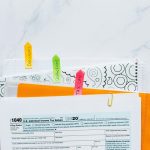Yes, the new desk, chair, or computer you bought for your home office can be a tax deduction if you use them exclusively for business purposes. To qualify, your home office must be your principal place of work, and you should keep records of your expenses. You can usually deduct a portion of these costs from your taxable income. Want to know more about maximizing your deductions? There’s plenty to explore on this topic!
Table of Contents
Key Takeaways
- A new desk, chair, or computer can be deducted if used exclusively for business purposes in a qualifying home office.
- Ensure your home office is your principal place of business to qualify for these deductions.
- Keep accurate records of expenses and track the business use percentage for deductibility.
- Determine if the items qualify for immediate expensing or if they need to be depreciated over time.
- Consult a tax professional to ensure compliance and maximize potential deductions for your new office equipment.
Understanding the Home Office Deduction
Have you ever wondered how the home office deduction can benefit you? This deduction allows you to claim expenses related to your home workspace, reducing your taxable income.
Fundamentally, it’s designed to help cover costs that come with maintaining a home office. You can write off a portion of your rent or mortgage interest, utilities, and even internet costs.
If you’re self-employed or work remotely, this can lead to significant savings on your taxes. Plus, it makes your home office setup feel more financially justified.
By understanding this deduction, you’re taking a step towards maximizing your financial benefits while keeping your workspace efficient.
Eligibility Criteria for Home Office Deductions
To qualify for home office deductions, you must meet specific eligibility criteria set by the IRS.
First, your home office should be used exclusively for business purposes. This means you can’t use the space for personal activities.
Your home office must be dedicated solely to business activities, with no personal use allowed.
In addition, your home office must be your principal place of business, where you conduct most of your work. If you use it to meet clients or customers regularly, that can also qualify.
Additionally, you need to keep accurate records of your expenses related to the home office. This includes utilities, repairs, and depreciation.
Finally, verify your business is legitimate and report any income generated from it. Meeting these criteria is essential for maximizing your deductions.
Types of Expenses You Can Deduct
When it comes to tax deductions for new office equipment, you can claim a variety of expenses that directly support your business operations.
First, consider costs for purchasing desks, chairs, and computers, which enhance your workspace. You can also deduct expenses for office supplies like printers, paper, and ink.
If you invest in software necessary for your business, that’s deductible too. Don’t forget about expenses for repairs or maintenance of your equipment, as they can also reduce your tax liability.
Additionally, you might be eligible to deduct a portion of your utilities if your equipment is used within a home office.
Always keep receipts and documentation to support your claims, ensuring you maximize your deductions.
How to Calculate Your Deductions
Calculating your deductions for new office equipment involves a few straightforward steps. First, determine the total cost of the items you’ve purchased.
Next, check if any of these items qualify for immediate expensing or if you’ll need to depreciate them over time. Then, keep track of your business use percentage, as only that portion is deductible.
Determine if your equipment can be immediately expensed or needs depreciation, and track your business use percentage for deductions.
Finally, fill out the appropriate forms when you file your taxes. Here’s a quick checklist to follow:
- Total Cost: Add up all your expenses for the equipment.
- Expensing vs. Depreciation: Decide how you’ll deduct these costs.
- Business Use Percentage: Calculate how much you use the items for business.
- Tax Forms: Get the forms ready for filing.
Record-Keeping Tips for Tax Deductions
When it comes to maximizing your tax deductions, good record-keeping is essential.
You’ll want to organize your receipts efficiently, manage digital records, and maintain accurate expense logs.
Let’s explore how these strategies can simplify the process and help you stay on top of your deductions.
Organizing Receipts Efficiently
To maximize your tax deductions for new office equipment, organizing receipts efficiently is essential. Here are some tips to help you keep track:
- Sort by Category: Group your receipts into categories like furniture, electronics, and supplies. This makes it easier to find what you need.
- Use a Folder System: Maintain a physical or digital folder for each category. This way, you’ll have everything in one place.
- Record Dates: Note the purchase date on each receipt. This helps you determine which tax year to include them in.
- Review Regularly: Set aside time each month to review and update your records. This prevents last-minute scrambles during tax season.
Digital Record Management
Keeping your receipts organized is just the first step; effective digital record management can streamline the process even further. By scanning your receipts and organizing them into folders, you’ll save time and stress come tax season. Use cloud storage to guarantee you can access your records anywhere, anytime.
Here’s a simple structure to follow:
| Folder Name | Contents |
|---|---|
| Office Equipment | Scanned receipts |
| Software Purchases | Invoices and licenses |
| Home Office Expenses | Utility bills |
| Tax Documents | Previous returns |
With this system, you’ll quickly find what you need, making it easier to maximize your deductions while minimizing headaches. Stay organized, and you’ll thank yourself later!
Maintaining Expense Logs
An organized expense log is essential for maximizing your tax deductions. Keeping track of your office equipment purchases helps guarantee you don’t miss out on valuable deductions come tax time.
Here are some tips to maintain an effective expense log:
- Date of Purchase: Record when you bought the item to establish the timeframe for deductions.
- Description: Write a brief note about the item, including brand and model, for clarity.
- Amount: Note the exact cost, including taxes and shipping fees, to capture the total investment.
- Receipts: Keep digital or physical copies of receipts to support your claims if needed.
Common Mistakes to Avoid
While it may seem straightforward to claim tax deductions for new office equipment, many people make common mistakes that can lead to missed opportunities or costly errors.
One key error is failing to keep detailed records of your purchases. Without receipts and documentation, you can’t prove your expenses.
Another mistake is misclassifying equipment; know whether it qualifies as a deductible expense or needs to be capitalized.
Additionally, you might overlook depreciation, which can considerably impact your deductions over time.
Finally, don’t forget to check for any eligibility requirements based on your business structure.
By avoiding these pitfalls, you can maximize your tax benefits and guarantee compliance with IRS regulations.
Stay organized and informed to make the most of your deductions.
When to Consult a Tax Professional
If you’re unsure about how to meet the business use requirement for your new office equipment, it’s time to consult a tax professional.
They can help you navigate the complexities of tax code nuances that could impact your deductions.
Don’t leave money on the table—get expert advice to guarantee you’re making the most of your investments.
Business Use Requirement
When you purchase new office equipment, understanding the business use requirement is essential for maximizing your tax deductions. To qualify for deductions, you need to verify that the equipment is used primarily for business purposes.
Here are four key points to take into account:
- Percentage of Use: If you use the equipment for both personal and business, only the business portion is deductible.
- Documentation: Keep detailed records of usage to support your deductions.
- Type of Equipment: Certain items like computers and desks may have specific guidelines regarding deductions.
- Consulting a Tax Professional: When in doubt, seek expert advice to navigate the complexities of tax regulations and verify compliance.
Tax Code Nuances
Understanding the business use requirement is just the start; maneuvering through the tax code nuances can be tricky. The IRS has specific guidelines on what qualifies for deductions, and these can vary based on your business structure.
For instance, if you’re self-employed, your deductions may differ from those of an employee working from home. You might also need to take into account depreciation rules and how they apply to office equipment.
If you’re unsure about any aspect, it’s wise to consult a tax professional. They can help clarify your eligibility, guarantee you’re maximizing your deductions, and keep you compliant with IRS regulations.
Don’t navigate these complexities alone; expert guidance can save you time and money.
Frequently Asked Questions
Can I Deduct Furniture Purchased Before Starting My Home Business?
You can typically deduct furniture purchased for your home business if it’s used exclusively for business purposes. However, since you bought it before starting, you might want to consult a tax professional for guidance.
What if I Use My New Desk for Personal Tasks Too?
If you use your new desk for both personal and business tasks, you can only deduct the percentage of its cost related to your business use. Keep accurate records to support your deduction claim.
Are There Limits on the Cost of Deductible Office Equipment?
When you envision your sleek new desk gleaming in the sunlight, remember there are limits on deductible office equipment costs. You can typically deduct expenses that are ordinary and necessary for your business, so keep that in mind.
Can I Claim Tax Deductions for Used Office Furniture?
Yes, you can claim tax deductions for used office furniture, provided it’s used for business purposes. Just make sure you have proper documentation, and the furniture meets the necessary criteria set by tax regulations.
How Does Depreciation Affect My Office Equipment Deductions?
Depreciation impacts your office equipment deductions greatly. While you might expect immediate savings, the value of your equipment decreases over time, allowing you to spread those deductions across several years instead of claiming everything at once.



